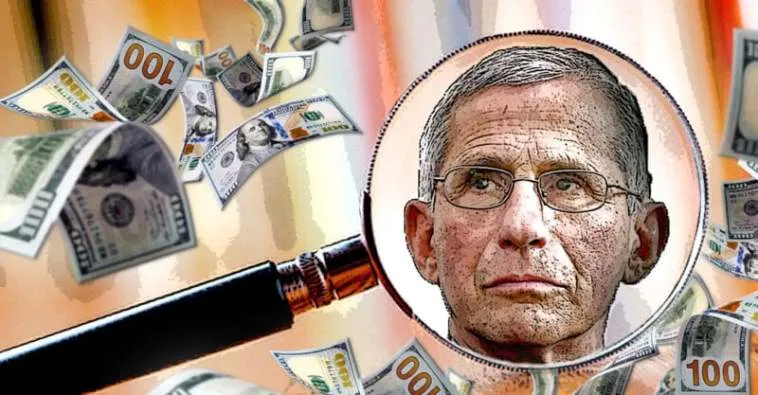(The Defender) Newly released National Institutes of Health (NIH) documents show conclusively that statements made during congressional hearings to U.S. Sen. Rand Paul (R-Ky.) and Rep. John Moolenaar (R-Mich.) by then-NIH leaders Dr. Anthony Fauci and Lawrence Tabak D.D.S., Ph.D., were misleading, if not outright false, regarding third-party royalties paid before, during and after the pandemic.
Tabak, then-acting director of the NIH and Fauci, then-director of the National Institutes of Allergies and Infectious Diseases (NIAID), both claimed before Congress that they could not release the names of the companies paying NIH third-party royalties.
Last week, however, our based on our Freedom of Information Act (FOIA) request caused NIH to release new documents.
The newly released documents reveal — for the first time — the names of companies that paid NIH scientists $325 million in third-party royalties from 56,000 transactions between September 2009 and October 2020.
Our OpenTheBooks oversight reporting — which led to three congressional hearings during 2022 regarding NIH’s secret third-party royalty payments — is available here for review.
Here are some key findings from the new disclosures:
- In U.S. Senate hearings during 2022, Fauci refused to disclose the companies who licensed his “inventions” and paid his third-party royalties. Finally, now, we know the companies paying him. They are listed below.
- Chinese government-owned pharmaceutical companies, controlled by the Chinese Communist Party, paid the NIH third-party royalties to license technologies developed on the U.S. taxpayer dime. One such company neighbors the Wuhan Institute of Virology collaborates with the lab, and even paid a royalty to Douglas Lowy, a multiple-term acting director at the National Cancer Institute, a sub-institute of NIH.
- Russian animal vaccine maker — which was allegedly a front for a Soviet bio-weapons lab — licensed inventions and paid royalties to NIH for tech developed with taxpayer dollars.
- Purdue Pharma — the makers of the highly addictive and frequently abused OxyContin (oxycodone) — licensed tech developed with public funds and paid royalties to NIH — even after the company pleaded guilty to federal crimes relating to opioids.
- Long-serving former NIH director, Francis Collins, M.D., Ph.D., received third-party royalties on his inventions from four companies that themselves received nearly $50 million in federal contracts and grants since 2008.
During the pandemic, the American people started to worry that Big Government was too close to Big Pharma.
Now, because of our oversight investigation at OpenTheBooks.com, we know just how close they are: NIH spends billions on the industry and now we know the industry sends millions back to NIH and its scientists.
Last year, the NIH — Fauci’s former employer — doled out more than $30 billion in government grants to roughly 56,000 recipients. That taxpayer largess buys plenty of friends and enormous influence across the entire U.S. healthcare complex — the scientific, research, drug, therapeutic and healthcare industries.
In turn, $325 million in royalty payments flowed back in the other direction from private companies, research outfits, non-profits and academia to NIH and its scientists.
These payments from third-party payers enriched the agency, its leadership, and 2,400 individual NIH scientists. It took our FOIA request — ignored by NIH in September 2021 — and our federal lawsuit filed in November 2021 to finally force the production of these payment records. The public interest law firm, Judicial Watch, represents us.
Supported by Tabak and Fauci’s false testimony to Congress, NIH initially redacted the name of the payor (company), the amount paid to the individual scientist (think Fauci) and what was invented by the taxpayer-paid scientist in the government lab (license/patent number) from their initial 3,000 pages of court-ordered production during 2022.
With so much information completely blacked out, the pages NIH produced were virtually useless for the purpose of scrutinizing these records for potential conflicts of interest or public health risks.
Their production defied the court and the public’s right to know. For a gaggle of doctors, they were treating the sunlight of transparency like an unknown pathogen.
 Top 10 companies paying royalties to NIH scientists ranked by payment count. The agency is still redacting the actual payment amount.
Top 10 companies paying royalties to NIH scientists ranked by payment count. The agency is still redacting the actual payment amount.
Significant transparency victory achieved
Until last week. That’s when NIH provided new production disclosing a partial two of the three formerly redacted items on all royalties paid since 2009: 1. The name of the third-party payor; and 2. The license number on the NIH invention.
NIH still refuses to disclose the dollar amount paid to the individual scientist and will not disclose patent numbers either. We will exhaustively litigate what we consider to be NIH’s smoking cover-up gun of defiance toward informing the taxpayers whose agency it is.
Background: What is a third-party royalty? When a government scientist invents something, it can be licensed to the private sector for enhancement, distribution and profit-making. Under the law, the private entity pays royalties back to NIH — enriching the agency, its leaders and its scientists.
Watch the U.S. Senate hearing where Fauci obfuscated and defended secrecy at the expense of our right to know while being questioned by Paul:
Fauci, Collins, et al. — who paid them?
We now know “Who” paid royalties to agency leadership, top scientists at NIH and everyone else.
Download our entire proprietary database of NIH third-party royalties since 2009 produced by the agency itself, here. Let us know what you find.
Well-known scientists receiving payments during the period included:
Collins, the director of NIH from 2009-2021 who served as President Biden’s COVID-19 czar in 2022 (Public salary: $300,000). Collins received 21 royalty payments between 2010 and 2021.
- Specialty Laboratories, Inc. (4 royalty payments) — provides biological testing services and was acquired by Quest Diagnostics in 2007. The company received $40.1 million on 403 contract payments from many U.S. agencies since 2008.
- ISIS Pharmaceuticals, Inc./Ionis Pharmaceuticals (4 royalty payments) — specializes in RNA-targeted therapeutics. Ionis changed its name from ISIS in 2015. The company received $2.2 million in federal contracts (including DARPA) since 2008.
- GeneDx, Inc. (12 royalty payments) — founded in 2000 by two NIH alumni involved in genetic research. The company received $5 million on 155 contract payments, mostly from NIH, since 2008.
- Progeria Research Foundation (1 royalty payment) — a nonprofit dedicated to finding treatments and a cure for the congenital disorder. The organization received $407,887 in federal grants since 2008.
Fauci, the immediately retired director of the NIAID and highest-paid federal bureaucrat since 2019, received 37 royalty payments (2010-2021). (Fauci’s 2022 taxpayer-funded salary: $480,654.)
Here are the companies that paid Fauci, according to NIH disclosures:
- Ancell Corporation (14 royalty payments) — produces immunology tolls intended for scientific research and payments spanned the years 2012 through 2016. License: +L-257-95/0.
- Santa Cruz Biotechnology (15 royalty payments) — creates products for medical research, including antibodies and payments spanned a decade, years 2011 through 2021. Licenses: +L-012-07/0, +L-012-07/1, +L-012-07/2 (Overall — when ranked by number of royalties paid since 2009, Santa Cruz was #5 out of 2019 companies in the database.).
- Chiron Corporation (8 royalty payments) — focused on biopharmaceuticals, vaccines, and blood testing. Fauci’s royalties continued through March 2014 on License: +L-167-95/1.
The new disclosures allow for fact-checking of Fauci’s U.S. Senate testimony (June 16, 2022).
Paul asked: “Can you tell me that you have not received a royalty from any entity that you ever oversaw the distribution of money in research grants?”
Fauci answered: “You know, I don’t know as a fact, but I doubt it.”
In 2004, Fauci’s NIAID contracted with Chiron to develop a vaccine for avian influenza (bird flu). Fauci said: “Information generated under this task order will be important for preparing our nation and the world against new influenza viruses with pandemic potential.”
In 2005, then-reporter John Solomon at the Associated Press successfully used FOIA to crack open the full NIH royalty database — including payments to individual scientists.
Fauci was among the 51 scientists found doing experiments involving inventions for which they were being paid royalties.
Between 1997 and 2004, Fauci received $45,072.82 in royalties from Chiron Corp. for a patent license on an experimental AIDS treatment (interleukin-2). Then, NIAID funded it with at least $36 million for testing on patients at 200 sites across 18 countries over five years.
In 2009, studies published in The New England Journal of Medicine showed the invention yielded “no clinical benefit” during a ten-year period. The prestigious Cochrane Review recommended against the agent citing harmful side effects and little efficacy.
When challenged about collecting the payments and later making decisions about related research funding, Fauci said he’d donate his royalties to charity — but never provided proof.
In 2005, Novartis acquired Chiron Corp. Novartis is the #10 ranked company on the count of royalty payments (324) at NIH since 2009.
Since 2008, Novartis received $2.3 billion in contract payments from multiple federal agencies including $17 million in contracts and $15 million in grants from NIH. Much of that funding was during a period when Fauci was receiving “Chiron” royalty payments.
Douglas Lowy has been the Acting Director of the National Cancer Institute (NCI) for three periods since 2015 and the deputy director of that institute since 2010.
He has directed a research laboratory at NCI since 1975 and also held the title of chief of the Laboratory of Cellular Oncology within the agency’s Center for Cancer Research.
Lowy is one of the top royalty receivers at NIH with 192 payments since 2009 from 32 companies. Here is a sample:
- Wuhan Institute of Biological Products Co. Ltd. (one royalty payment) — a subsidiary of the state-owned pharmaceutical company Sinopharm. In 2016, the company moved next to the Wuhan Institute of Virology and collaborates with that lab. (In total, this institute made 64 royalty payments to NIH scientists during the period 2009-2019.)
- Merck (33 royalty payments) and GlaxoSmithKline (13 royalty payments) — the companies then marketed vaccines that used Lowy’s inventions as Gardasil, Gardasil 9 and Cervarix, respectively.
Gardasil and Gardasil 9 generated $1.5 billion in sales for Merck alone in 2021. (NIH redacts the amount of the payment, so we do not know how much money Lowy made from these payments. However, NIH rules limit staff from receiving more than $150,000 a year in royalties. Any payments in excess go back to the agency itself.)






